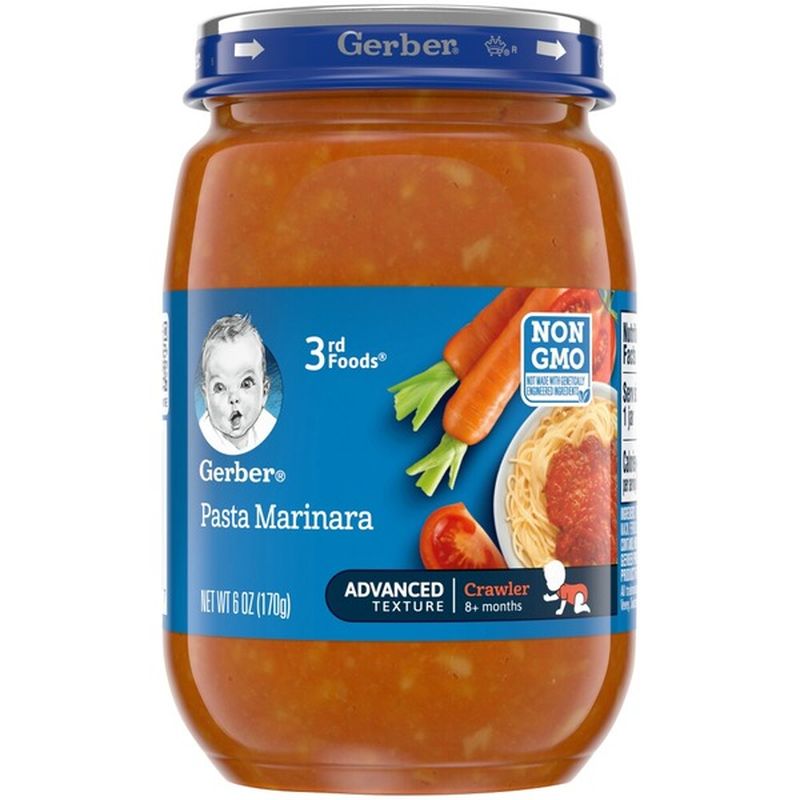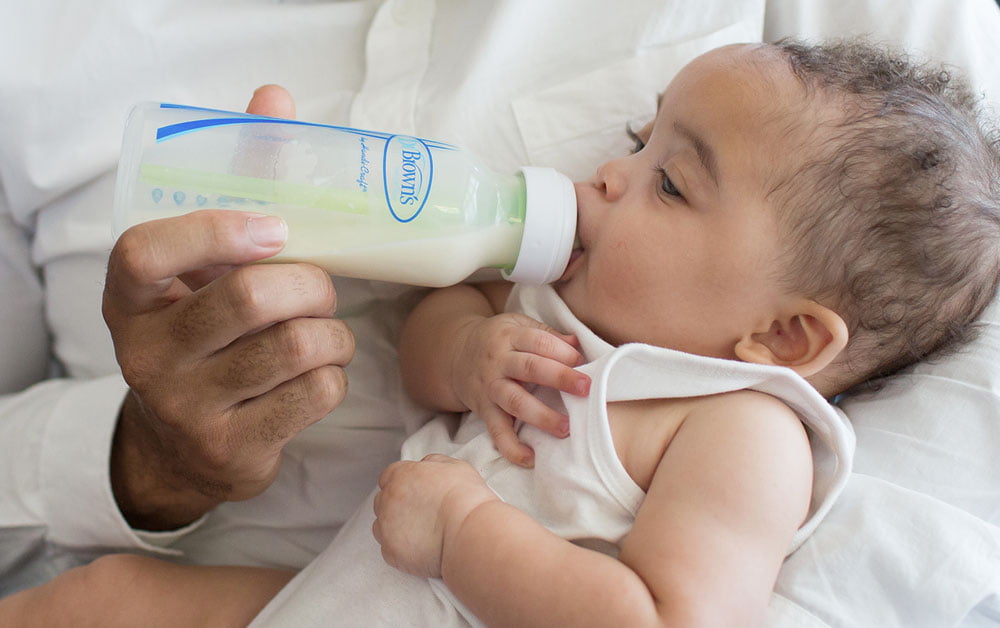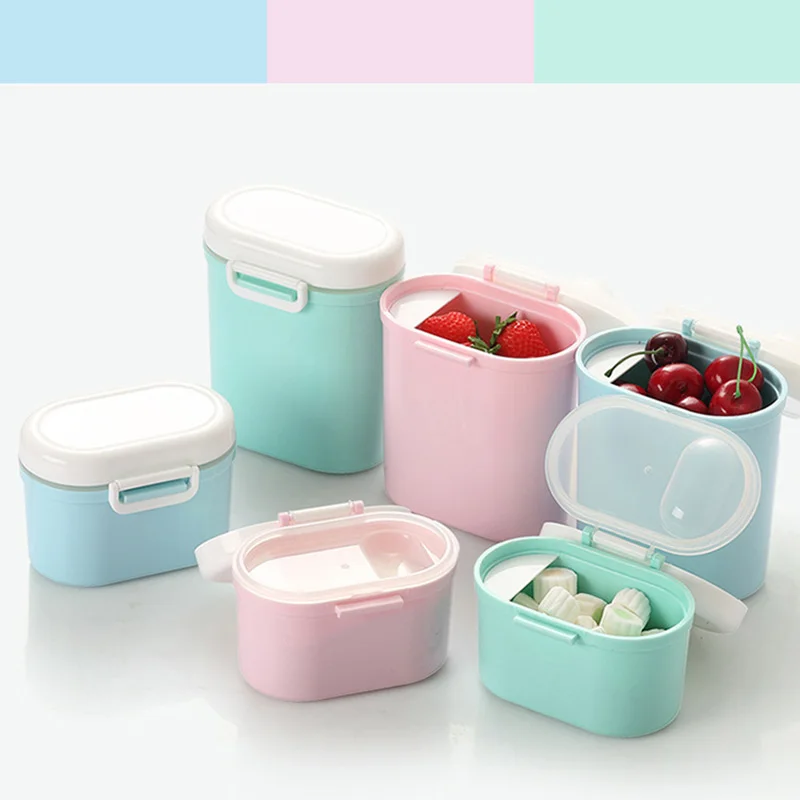Gerber baby food guidelines
Does It Offer Complete Nutrition?
Written by Lorraine Bunag, R.N. Updated Oct 07
Medically reviewed by Ruben Macapinlac, MD, DPPS
Is your baby finally starting on solid foods? If that’s the case, you as a parent might be a little overwhelmed on how to wean them off the breast (or bottle). You might have spent some time on the internet about how to prepare baby food at home and also come across options of baby food in jars, like Gerber baby food. If you find commercially-prepared baby food appealing, particularly the Gerber brand, this article will be helpful.
About Gerber Baby FoodGerber has been in the industry of producing baby food since 1927. In the Philippines, they are under Nestle and mostly offer 100% pureed vegetables and fruits with zero added salt, sugar, color, preservatives, and flavors.
On their website, they highlighted that “Every jar of GERBER® is carefully grown using our Clean Fields Farming™ practices. This ensures our purees are not only nutritious but also wholesome and safe for our little ones’ tummies.”
Gerber baby food can be given to babies 6 months to 2 years old. But, of course, if you plan on giving it to your baby once they turn 6 months, you still have to take into account their readiness for solid foods. You must also consult your Pediatrician for this plan in order to give you proper advice and guidance.
Reminders When Giving Gerber Baby FoodGerber has several products. First Foods offer single-ingredient puree (carrot, banana, squash, etc.) These are great for introducing your baby to the taste of fruits and vegetables ONE AT A TIME. They also offer Second Foods where one jar contains at least two fruits and/or vegetables (banana & strawberry, apple & blueberry, etc.)
You can give Gerber to your baby at room temperature or warmed (just test the temperature beforehand). Once opened, you can refrigerate what’s left but it should be consumed within 24 hours.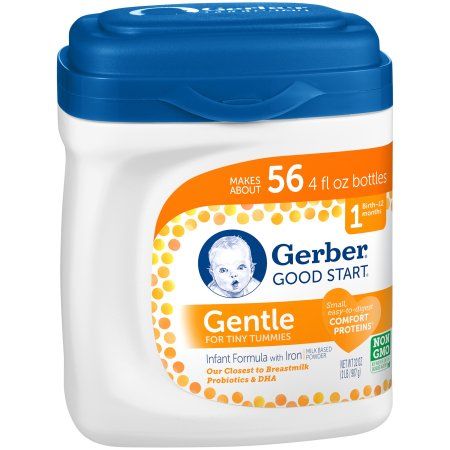 You must also use a non-metal spoon.
You must also use a non-metal spoon.
IMPORTANT:
A jar of Gerber is NOT complete nutrition for your baby. Particularly when they are just starting on solids, you must still give them breast milk or formula milk. Gerber can be a good option if you want to introduce the taste of different fruits and vegetables to your baby. As they grow older, they’ll need more. Hence, you need to provide them with a variety of fruits, vegetables, starch, lean protein, dairy, and healthy fats.
Don’t start with solids until your baby is ready to make the transition from breast milk or formula. It’s important to wait until your baby can sit up on his own, has lost the tongue-thrust reflex (the tendency of an infant to push out solid food with his tongue), and shows signs of interest in foods other than breast milk or formula.
A newborn will begin eating solid foods at around 6 months, but every child is different. Some may be ready earlier, while others may not show interest until they are a bit older. If you’re worried that your child isn’t getting enough nutrients from breast milk or formula alone after 6 months of age, talk to your doctor about introducing solids.
If you’re worried that your child isn’t getting enough nutrients from breast milk or formula alone after 6 months of age, talk to your doctor about introducing solids.
If you decide to prepare their food along with Gerber baby food (or other commercially-prepared foods), you can check out this article:
The following reminders would be helpful:
Heat pureed fruits and vegetablesDo not give your baby pureed raw vegetables or fruits. Heat the puree at about 180 F or at a simmering temperature. Let cool and serve.
Don’t add sugar, salt, or honey to your baby’s foodYou should avoid adding sugar, salt, and honey to your baby’s food. Honey CANNOT be given until they are a year old. Avoid artificial sweeteners, too.
If you want to add something sweet, use a small amount of fruit or vegetable puree instead. These can be mixed with breast milk or formula if it suits your child’s taste – but make sure that there is no added sugar in the puree itself!
Wait a little bit longer for foods containing allergensAvoid nuts.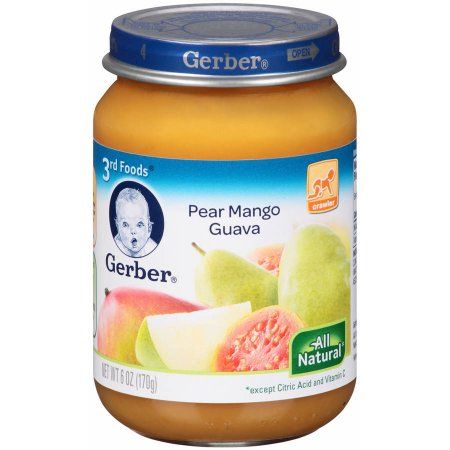 If you are unsure of what your baby is allergic to, start with ONE food containing an allergen first. Give them a small amount and just gradually increase as you see that they can tolerate it. Pediatricians now encourage babies to eat eggs and shellfish in order to desensitize them if they have allergies.
If you are unsure of what your baby is allergic to, start with ONE food containing an allergen first. Give them a small amount and just gradually increase as you see that they can tolerate it. Pediatricians now encourage babies to eat eggs and shellfish in order to desensitize them if they have allergies.
It is important to introduce new textures gradually. This is because your baby may not be ready for all foods, so it’s best to proceed slowly and patiently.
You should not give them:
- Food that is too hot or too cold. This can burn their mouth or make them feel sick.
- Spicy and sour food. They don’t give them good experience with solids and can upset their stomach.
- Sugary foods. Remember that your baby doesn’t need extra sugar.
Key Takeaways
Whether you choose to introduce solids by giving them Gerber baby food or home-prepared food, the most important thing is to keep your baby’s first foods simple and healthy. As you introduce new textures and flavors, remember that every baby is unique. Some will take to solids more quickly than others—and there’s nothing wrong with that! If your baby seems ready for a new type of food but doesn’t seem to enjoy it, don’t force them to eat more than they want. Try again in a few days when they might be more receptive or try another food instead.
As you introduce new textures and flavors, remember that every baby is unique. Some will take to solids more quickly than others—and there’s nothing wrong with that! If your baby seems ready for a new type of food but doesn’t seem to enjoy it, don’t force them to eat more than they want. Try again in a few days when they might be more receptive or try another food instead.
Learn more about Baby Nutrition here.
Feeding Guide: 6-12 Months - WIC South Dakota
This site requires javascript to operate correctly. Please enable it to continue.
On a desktop computer, hold "Ctrl" and Press "F" to search for keywords on this page.
Please note: This information primarily focuses on nutrition for the healthy, full-term infant. Consult with a WIC Health Professional for more detailed and advanced information particularly for preterm, low-birth weight, special needs, or infants with medical conditions.
Breastfed Baby
It is recommended by the American Academy of Pediatrics to exclusively breastfeed (no formula) through the first 6 months of life and to continue breastfeeding through 12 months of age while complementary foods are added, as mutually desired by mom and baby.
Breastmilk is still the main source of nutrition. Continue to breastfeed on demand. On average, baby will feed 3-4 times per day.
Baby will start to breastfeed less as they eat more baby food and table foods. “Table foods” refers to foods the rest of the family eats at meal times. Table foods are the next step after baby has mastered baby foods and is developmentally ready for more chewing, texture, and flavor.
Baby food and table foods are for learning new flavors and textures as well as learning to chew and eat from a spoon, with fingers, and to start self-feeding with utensils. Let them be messy and feed themselves. It is how they learn!
- WIC does not provide solid foods until 6 months, an age most babies are developmentally ready to try solids.
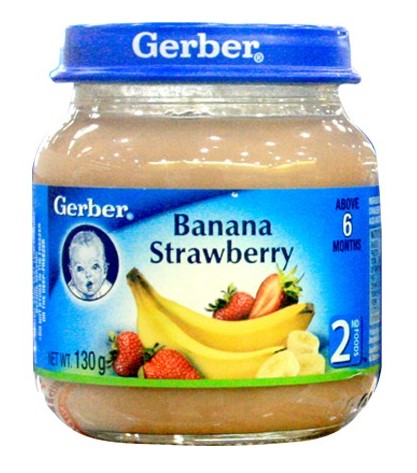
- WIC provides baby food until 12 months of age.
Get more great breastfeeding information here!
Formula-fed Baby
Baby will start to consume less formula as they eat more baby food and table foods. It is important to continue providing formula through 12 months of age if not breastfeeding.
Formula is still the main source of nutrition. Continue to offer formula on demand. On average, baby will drink 24-32 ounces total per day (about 3-4 8oz bottles per day)
Baby food and table foods are more for learning new flavors and textures as well as learning to eat from a spoon, with fingers, and to start self-feeding with utensils.
- Table foods are referring to foods the rest of the family eats at meal times. Table foods are the next step after baby has mastered baby foods and is developmentally ready for more chewing, texture, and flavor.
- Baby food is offered on your WIC package until 12 months of age.
Cow’s Milk & Other Liquids
Never give cow’s milk before 12 months. Why?
Why?
- Cow’s milk has too much protein, calcium, phosphorus, sodium, chloride, and potassium
- Cow’s milk lacks key nutrients like vitamin C, vitamin E, linoleic acid, iron, and copper
- Too much protein and minerals are hard on your baby’s kidneys, can cause dehydration, and it is hard for baby to digest.
- Cow’s milk can cause bleeding from the intestinal tract.
- Bleeding caused by cow’s milk increases your baby’s chance of becoming anemic (or low in iron).
At 12 months, whole cow’s milk can be offered until 24 months. See Feeding Guide for 1-2 year old for more information.
Water
- Water can be introduced from a cup, not a bottle at about 6 months.
- Offer a small amount of drinking water once solid foods are introduced to help babies get familiar with the taste. Just a few sips at meal times is all it takes.
- Drinking water at this age is more to practice using a cup than for nutritional needs. Let baby practice when he shows signs of readiness.

Other liquids
- Never give honey, syrup, kool-aid, pop, juice, or any sweetened drink to an infant.
- Juice is not recommended for babies less than 12 months of age.
No Honey Before 12 Months
Honey, including products that have honey cooked or baked in it, should not be fed to infants younger than 12 months due to risk of infant botulism.
- Foods cooked or baked with honey not heated to a certain temperature may still contain viable spores. When an infant eats foods with these invisible spores, the spores can produce a toxin that may cause infant botulism.
- Botulism can result in death.
- A child over 12 months can destroy the small amount of spores in honey, but an infant cannot.
Feeding Abilities
At 6-7 months, baby will:
- Use the whole hand or palm to pick up foods
At 8-9 months, baby will:
- Use their fingers to pick up foods.
- Reach for spoon to start spoon feeding themselves, may need help
- Can drink from a cup that is held or may begin to hold a cup
Introducing Food
Introduce foods around 6 months of age when showing signs of readiness.
Signs of Readiness
- Holds neck steady
- Sits without support
- Opens mouth when food is offered
- Draws in lower lip when spoon is removed from mouth
- Keeps food in mouth and swallows it
- Reaches for food showing interest
Starting solids too soon can…
- Cause choking
- Be hard for baby to digest
- Prevent baby from getting enough breast milk or formula for best growth
Food can be offered in different ways.
- Baby-Led Weaning method (also known as Baby-Led Feeding)
- Offering pureed baby foods
| 0-6 months | Breast Milk | 8-12 feedings on demand. Gradual decline in feedings at 4-6 months. | Feed on demand. Refrain from watching the clock. |
|
| Iron-Fortified Formula | 2-3 oz (increasing to consume around 32 oz at 6 months) | 6-8 feedings | ||
| 6-7 months | Breast Milk | Gradual decline in feedings.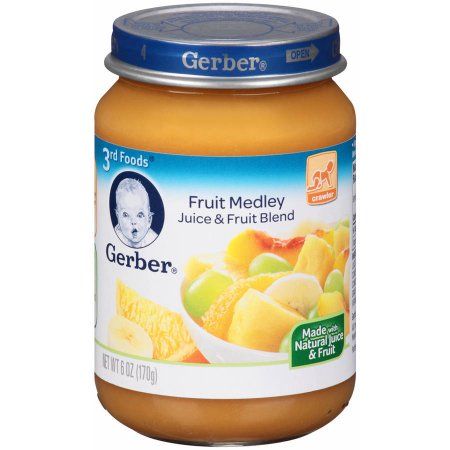 Continue feeding on demand. Continue feeding on demand. | Feed on demand. Refrain from watching the clock. |
|
| Iron-Fortified Formula | 6-8 oz (consuming 24-32 oz) | 3-5 feedings | ||
| Grains Infant cereal, bread, crackers | 1-2 Tbsp | 1-2 times per day | ||
| Vegetables AND Fruit Plain, strained, pureed, mashed | 1-2 Tbsp of vegetables 1-2 Tbsp of fruit | 1-2 times per day for vegetables 1-2 times per day for fruit | ||
| Protein Eggs, meat, poultry, fish, cheese/yogurt legumes; Plain, mashed, pureed | 1-2 Tbsp | 1-2 times per day | ||
| 8-12 months | Breast Milk | Gradual decline in feedings.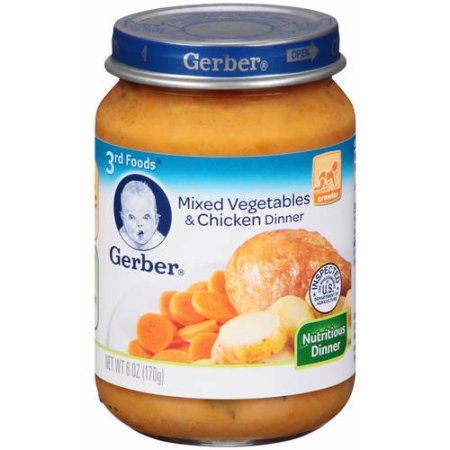 Continue feeding on demand. Continue feeding on demand. | Feed on demand. Refrain from watching the clock. |
|
| Iron-Fortified Formula | 6-8 oz | 3-4 feedings (6-8 oz each consuming 24 ounces) | ||
| Grains (Infant cereal, bread, crackers) | 2-4 Tbsp | 1-2 times per day | ||
| Vegetables AND Fruit (ground, finely chopped, diced) | 2-3 Tbsp of vegetables 2-3 Tbsp of fruit | 2-3 times per day for vegetables 2-3 times per day for fruit | ||
| Protein (meat, poultry, fish, eggs, cheese, yogurt, legumes; ground, finely chopped, diced) | 1-2 Tbsp | 1-2 times per day |
*Source: WIC Works Infant Nutrition and Feeding Manual.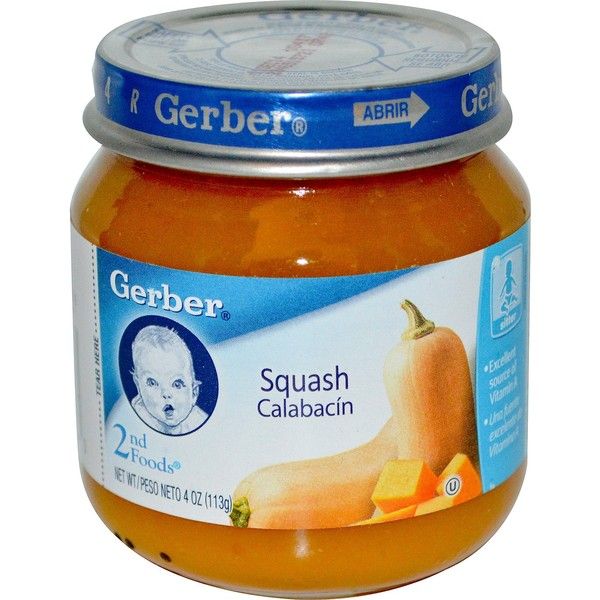
Feeding Tips for the 6-12 month old
- At any time between 6-12 months, daily amounts will vary. Never force your baby to eat all his food or finish a bottle. Baby will know when he is full and done eating! Look for signs of fullness.
- Baby’s tummy is small. It is important to feed healthy foods first.
- Less healthy food choices like cookies, chips, and candy can be a choking hazard but also do not give baby what is needed for proper growth and development.
- Offer fruit for dessert. Babies do not need desserts.
- Buy plain foods. Babies do not need added salt and sugar.
- Table foods should be soft and easy to chew. See the Choking section.
- A relaxed, pleasant atmosphere is an important part of feeding children of all ages. Be patient and give them time to practice. It will be messy but have fun with it!
- Let your baby sit at the table with the family!
- Always stay with baby when he is eating.
- Offer more breast milk, formula, or water in the cup as baby gets closer to age 1.
 This will help with weaning from the bottle soon after their first birthday. See section on Weaning: Breastfed Baby and Weaning: Formula-Fed Baby.
This will help with weaning from the bottle soon after their first birthday. See section on Weaning: Breastfed Baby and Weaning: Formula-Fed Baby. - Wipe baby’s gums and teeth with a soft damp cloth after meals. This will keep baby’s gums healthy.
- Wash your hands and baby’s hands with soap before feeding. Wash the high chair with warm soapy water after baby eats.
- See section on Food Safety to learn about how to safely handle and prepare food for you and your family.
- See section on Food Allergies to learn about the newest recommendations on how to best prevent food allergies from forming in children.
Sources: Healthy Eating Research, USDA Infant Nutrition & Feeding – A Guide for Use in WIC
This post was last updated on September 1st, 2022 at 2:39 PM
This institution is an equal opportunity provider.
Baby food Gerber | About the most beloved and beautiful
Every mother who cares about the health of her baby faces the problem of choosing baby food.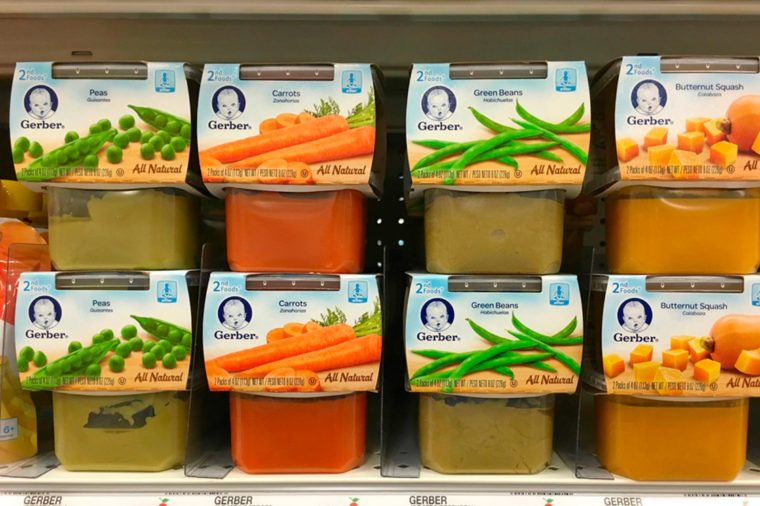 Which baby food is the most useful, what products it is made from, whether the baby will like it - these are questions that concern any mother. Much in the production of quality food for children depends on the integrity of the manufacturer. Therefore, when choosing baby food, you should trust more proven companies that have managed to establish themselves in the world market. nine0005
Which baby food is the most useful, what products it is made from, whether the baby will like it - these are questions that concern any mother. Much in the production of quality food for children depends on the integrity of the manufacturer. Therefore, when choosing baby food, you should trust more proven companies that have managed to establish themselves in the world market. nine0005
Gerber has been making baby food for over 80 years. The company's products are distinguished by a wide range, high quality raw materials, the use of the most advanced technologies for the production of tasty and healthy baby food. Gerber offers its customers fruit juices, fruit, fruit and cereal, meat, vegetable, meat and vegetable purees, fruit and milk desserts.
Gerber fruit and vegetable purees
From 4-5 months, pediatricians recommend introducing vegetables and fruits into the child's diet, which are important for the health and development of the child, because are a source of potassium, iron, organic acids and plant fibers. nine0005
nine0005
Complementary foods are a big step in your baby's nutrition. It is very important to choose the right products at the very beginning, as the health of the child also depends on this in the future. There is a lot of opinion and disagreement about the timing of the introduction of complementary foods. There are supporters of complementary foods for babies from 4 months. Some mothers introduce complementary foods when the child is 1 year old.
Doctors recommend introducing complementary foods from 6 months. The first complementary foods are usually started with fruit juices, vegetable and fruit purees. It is at this stage that the baby begins to get acquainted with the variety of new tastes.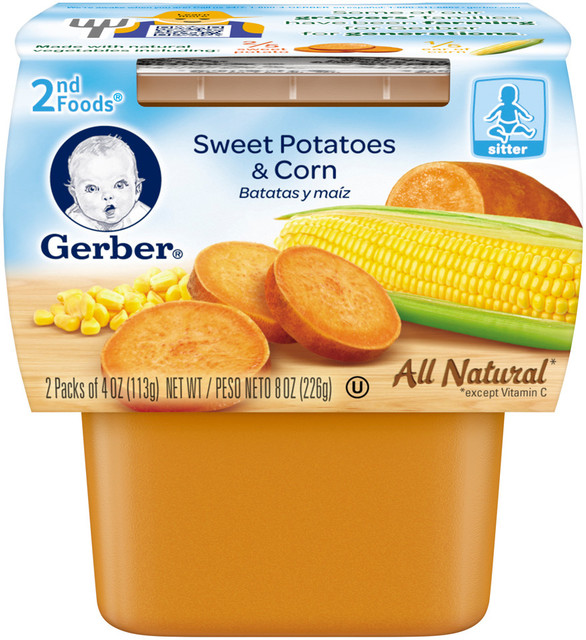 Quality baby food accelerates the physical development of the baby. But how, among the variety of manufacturers and names of companies producing children's products, to choose, and not be mistaken, high-quality nutrition, rich in all the necessary trace elements and vitamins?
Quality baby food accelerates the physical development of the baby. But how, among the variety of manufacturers and names of companies producing children's products, to choose, and not be mistaken, high-quality nutrition, rich in all the necessary trace elements and vitamins?
Pediatricians recommend introducing complementary foods for children with low weight in the form of cereals, and for overweight children - vegetable and fruit purees. It is recommended to introduce complementary foods gradually, starting with small doses of 1-2 teaspoons. It is better to give complementary foods at the beginning of the day, so that during the day you can monitor the condition of the child, to exclude allergic reactions. nine0005
Gerber one-component vegetable purees from carrots, cauliflower, white potatoes, pumpkin, broccoli and fruit purees from prunes, apples, pears, peaches are ideal for the first feeding. A little later, the baby can be offered multi-component purees: Cauliflower and Potato, Apple and Pear, etc.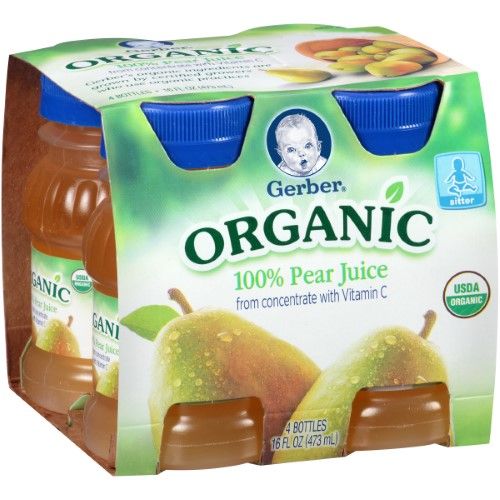 Gerber vegetable and fruit purees are made from environmentally friendly ripe fruits and vegetables without starch or preservatives.
Gerber vegetable and fruit purees are made from environmentally friendly ripe fruits and vegetables without starch or preservatives.
Vegetable puree is recommended to start with one-component puree. It is better to start with cauliflower or broccoli. If the child refuses some types of puree, it can be recommended to add fruit pieces that the baby likes to the puree. But, if the child categorically refuses the dish, in no case should you force-feed him. It is better to take a break and offer new food when the child comes from a walk and is hungry enough. nine0005
Now baby food in the trading network is presented in a huge amount and assortment. Well, thank God, there are plenty to choose from! Let's take a look at some of the popular and best-selling food products that are produced by Gerber.
Fruits, vegetables and meat from which baby food is produced do not contain genetically modified products, dyes, preservatives, flavor and aroma enhancers, stabilizers.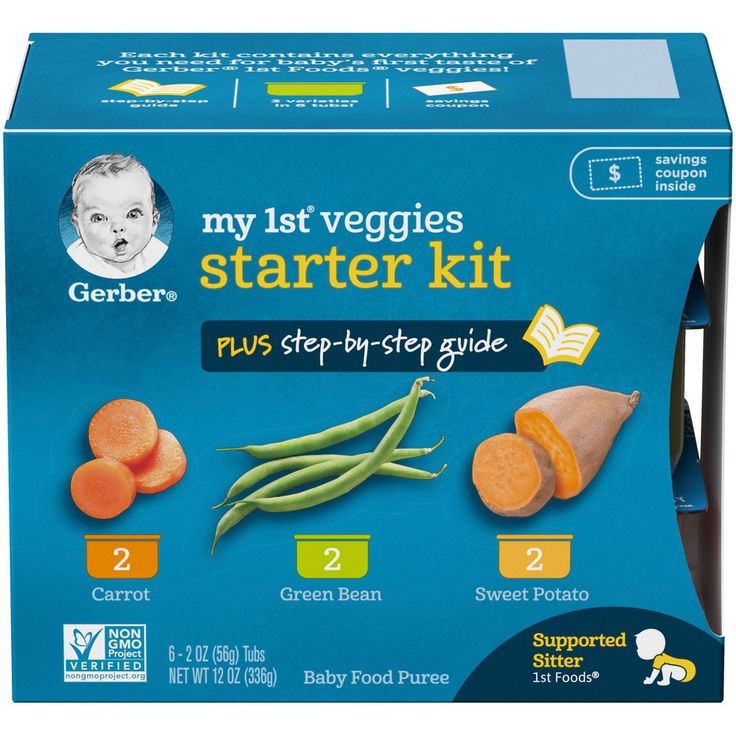 The company produces almost 70 types of baby food - fruit juice, fruit and vegetable purees, vegetable stews, fruit purees with cottage cheese. Gerber products are varied, tasty, natural, healthy nutrition for children. nine0005
The company produces almost 70 types of baby food - fruit juice, fruit and vegetable purees, vegetable stews, fruit purees with cottage cheese. Gerber products are varied, tasty, natural, healthy nutrition for children. nine0005
The company produces one-component and multi-component vegetable and fruit purees, which is very convenient to gradually introduce the baby to a variety of new foods. The advantages of Gerber baby food are the modern technological process of their preparation. All products of this company are not subjected to intensive heat treatment, and this allows the products not to change their natural color and taste. Gerber products are free of starch and thickeners. One-component vegetable purees are used for the first feeding: carrots, cauliflower, white potatoes, pumpkin, broccoli. Children like carrots, cauliflower, pumpkin very much. nine0005
Excellent one-component fruit purees: prunes, pear, apple, peach. Children especially like pear and apple. One-component purees of the first complementary foods can be given to babies from 4-6 months.
Lots of Gerber products for babies from 6 months. Puree from various vegetables with veal, rabbit and chicken is an ideal nutrition with the content of essential fatty acids Omega 3 and Omega 6, which contribute to the development of the brain, strengthen the child's vision and immunity. This is very important, since these acids can only enter the human body with certain foods. nine0046 From the age of 6 months, children can be offered fruit purees with cottage cheese, such as apricot, banana, strawberry, peach. The benefits of cottage cheese in baby food are great. This fermented milk product is rich in calcium, potassium, sodium, phosphorus, vitamin B12, B2. Cottage cheese contains a large amount of protein needed by a growing body.
Gerber products are also very convenient because the older the child, the more varied the food, and the volume of jars is increased according to age. Gerber juices also deserve special mention. We will not describe how useful juice is for a child's health, how many vitamins, organic acids and minerals it contains. It is very convenient that Gerber juices are also divided into single-component and multi-component. This allows you to enter them from 4 months. One-component apple and pear juices are low allergenic. Therefore, it is recommended to start complementary foods with them. As the child grows, multi-component juices such as apple and carrot can be introduced; apple, grapes and wild rose; apple, grape and mint, etc. The value of Gerber juices lies in the fact that they are all made without preservatives and sugar. Due to their natural taste and nutritional value, many mothers have approved Gerber juices and give them to their children. Gerber means healthy, strong children and calm mothers! Gerber is a reliable assistant for moms! nine0005
It is very convenient that Gerber juices are also divided into single-component and multi-component. This allows you to enter them from 4 months. One-component apple and pear juices are low allergenic. Therefore, it is recommended to start complementary foods with them. As the child grows, multi-component juices such as apple and carrot can be introduced; apple, grapes and wild rose; apple, grape and mint, etc. The value of Gerber juices lies in the fact that they are all made without preservatives and sugar. Due to their natural taste and nutritional value, many mothers have approved Gerber juices and give them to their children. Gerber means healthy, strong children and calm mothers! Gerber is a reliable assistant for moms! nine0005
Gerber fruit juices
Juice should not be introduced into the baby's diet before 4-5 months of age. You should start with single-component juices. Gerber produces apple juice (clarified or with pulp) and pear juice. Gerber juices made from two or more fruits: "Apple-Carrot", "Apple-Pear", "Apple-Peach", "Apple-Cherry" are perfect for children from 5 months.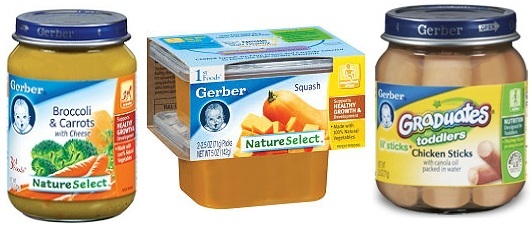
Gerber puree assortment
Gerber puree with cottage cheese. nine0005
An important baby food is cottage cheese, which contains a lot of protein and calcium salts. It is also rich in iron, vitamins B1 and PP. Gerber puree from apricot with cottage cheese, banana with cottage cheese, peach with cottage cheese and strawberry with cottage cheese is not only healthy, but also very tasty.
Gerber puree with cream.
The cream contains a large amount of easily digestible milk fat, as well as fat-soluble vitamins. Pear puree with cream, peach with cream, banana with cream, strawberries with cream, apricot with cream will please the baby. nine0005
However, it should be remembered that children with cow's milk intolerance should only be introduced to dairy products after consulting a pediatrician.
Gerber meat purees.
Meat puree is an essential food product for babies from 6 months. Meat contains vitamins, iron, protein and other nutrients that play an important role in the development and growth of the child.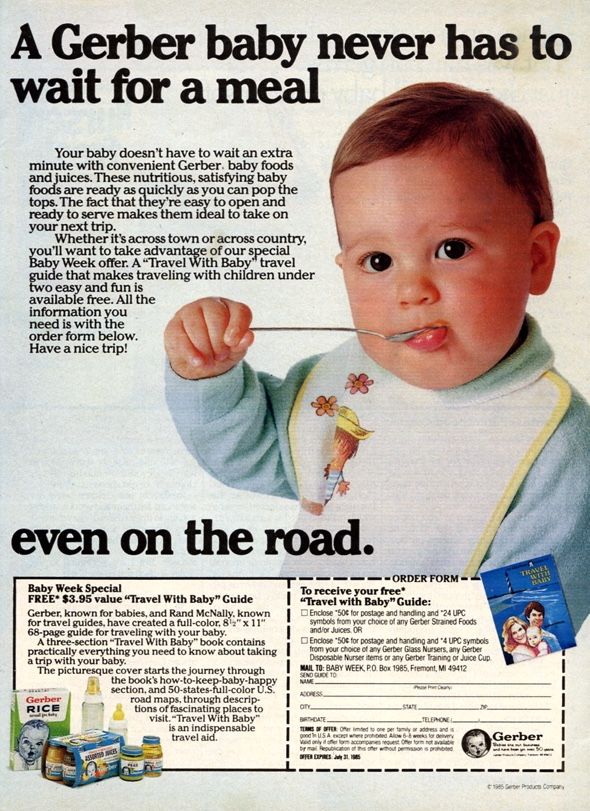 Gerber baby food are meat purees made from all types of meat suitable for a child: chicken, turkey, beef, veal, pork, lamb and rabbit. In addition to meat purees, Gerber baby food includes various types of vegetable puree with meat: vegetable puree with rabbit, veal stew with pumpkin and carrots, turkey stew with rice, etc.
Gerber baby food are meat purees made from all types of meat suitable for a child: chicken, turkey, beef, veal, pork, lamb and rabbit. In addition to meat purees, Gerber baby food includes various types of vegetable puree with meat: vegetable puree with rabbit, veal stew with pumpkin and carrots, turkey stew with rice, etc.
Taking into account all the possible taste preferences of its little consumers, Gerber is constantly expanding the range of products offered. Gerber DoReMi products are fresh fruit smoothies, fruit and cereal bars, cookies.
Gerber has achieved the most important thing - the baby food it produces has earned the trust of buyers in many countries of the world due to the observance of the main principle for every mother - tasty and healthy.
Record tags: baby food, baby health, baby food, palm oil
In baby food Gerber and Nurture Inc. found heavy metals
Experts from the Subcommittee on Economic and Consumer Policy of the US House of Representatives found dangerous levels of toxic metals in the baby food of several American brands.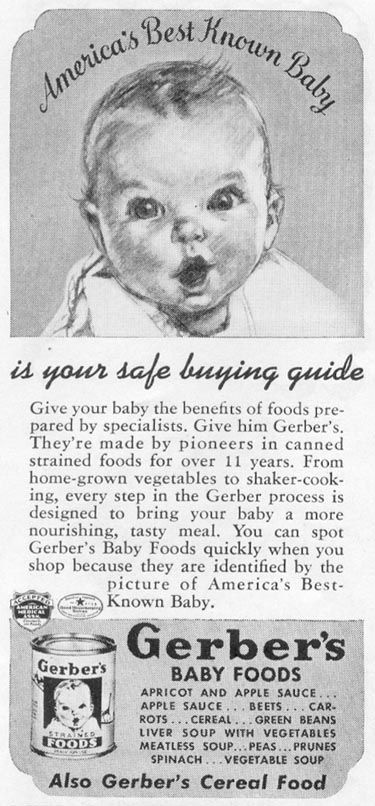 CNN writes about the progress of the investigation.
CNN writes about the progress of the investigation.
- Testing found high levels of substances such as arsenic, lead, cadmium and mercury in baby products. These heavy toxic metals pose a serious health hazard to children. nine0092
- Products from Gerber, Nurture Inc., Hain Celestial Group and Beech-Nutrition.
- Manufacturers are accused of knowingly selling these unlabeled products to parents who are unaware of the risks they are putting their children at.
- Experts and the World Health Organization also draw attention to the fact that exposure to these metals can lead to a decrease in intelligence, inhibition of the neurological development of infants and impaired brain function. nine0092
US baby food market situation
According to the 2019 Healthy Babies Bright Futures (HBBF) report, 95% of baby food samples tested contain at least one of four substances: arsenic, mercury, cadmium or lead.
- Experts tested 168 baby food brands.
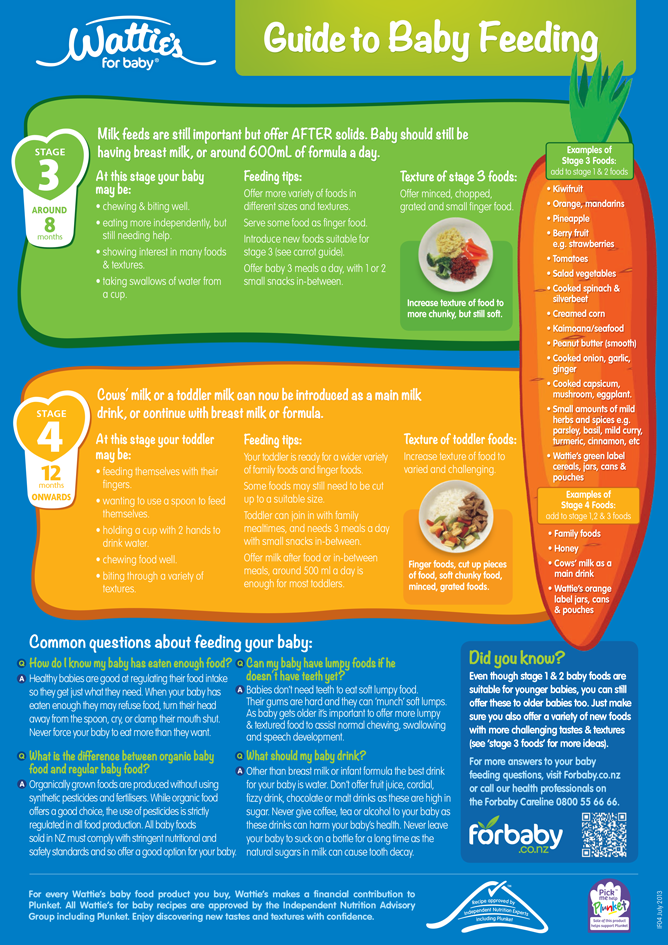 25% of them contained all four substances at once.
25% of them contained all four substances at once. - The researchers specifically recommended avoiding rice-based foods, as well as carrots, sweet potatoes, and fruit juices. nine0092
- Instead, scientists recommended steaming vegetables for children, feeding them cereals, fruits for breakfast, and using a frozen banana or chilled cucumber to relieve teething pain.
In Russia
In June 2019, Roskachestvo published a rating of 21 brands of dry mixes from Belarus (1), Germany (2), Denmark (3), Ireland (1), Spain (2), the Netherlands (4) , New Zealand (1), Russia (4), Finland (1), Switzerland (1) and Estonia (1), which are sold in Russia. nine0005
- Specialists did not reveal any violations, but only the Belarusian product showed full compliance with all quality standards.
- Experts tested the mixtures for microbiological safety and the presence of preservatives and antibiotics.
- The results showed that the products are "free of dangerous microorganisms (including salmonella), mold and yeast, preservatives and antibiotics, lead, mercury, cadmium and arsenic.
